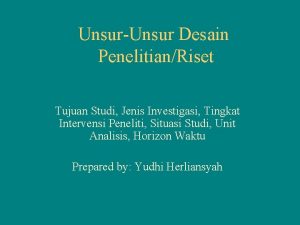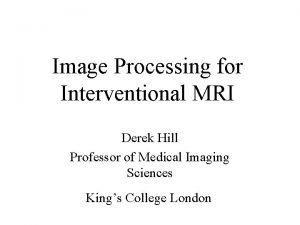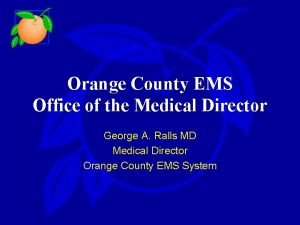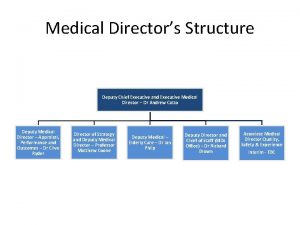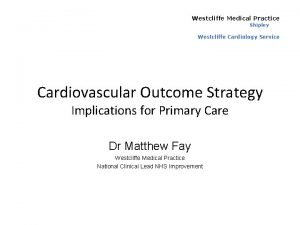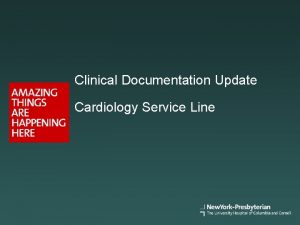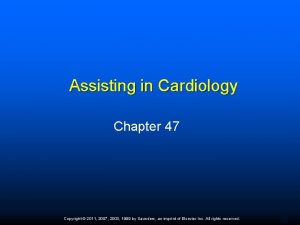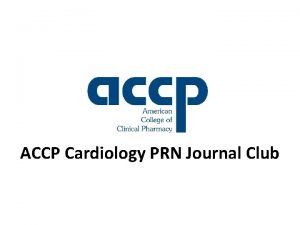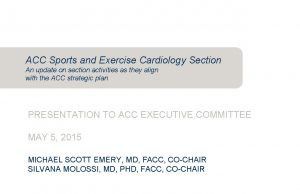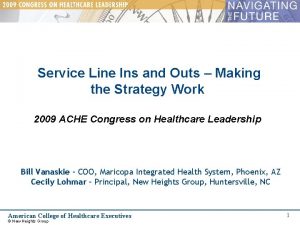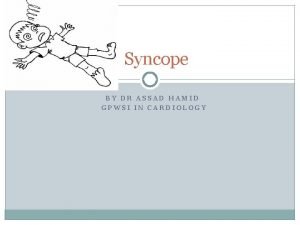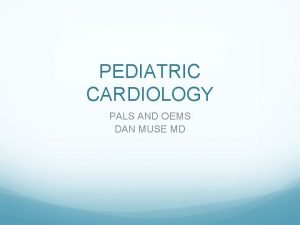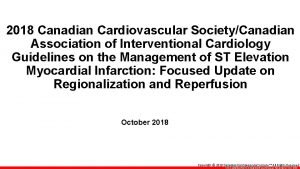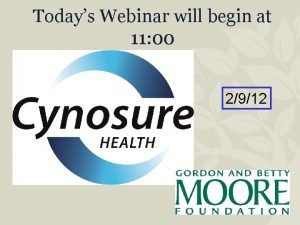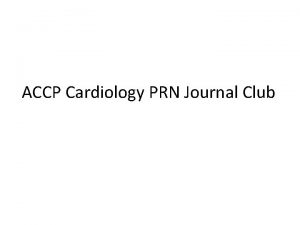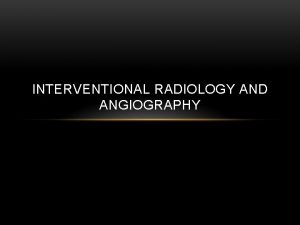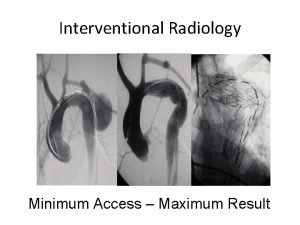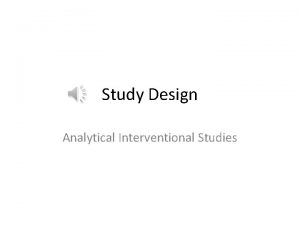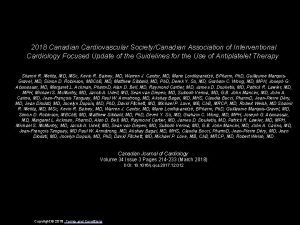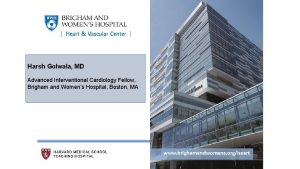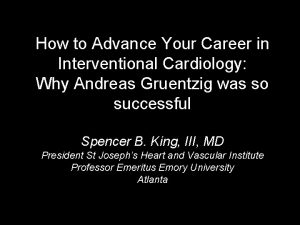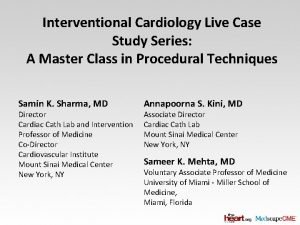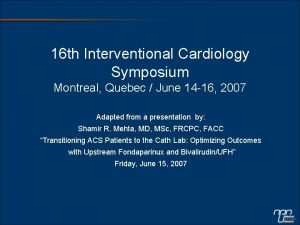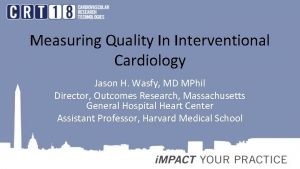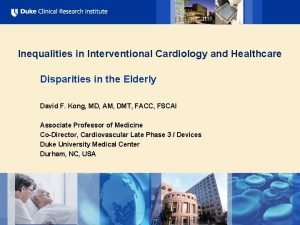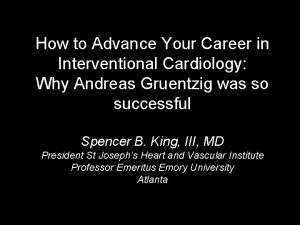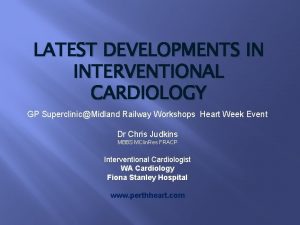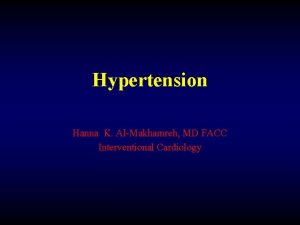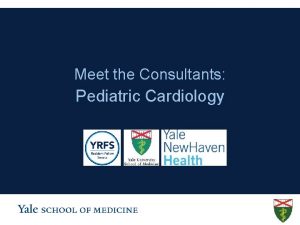You are the medical director of interventional cardiology























- Slides: 23

• You are the medical director of interventional cardiology at a large Academic Medical Center and one of the interventional cardiologist has asked for an appointment with you to discuss post-interventional care of patients with acute coronary syndromes in the hospital. The cardiologist, a well-respected individual who is loved by her patients, is concerned about the cost of treating patients with expensive antiplatelet therapy, Aspirin and Clopidogrel. However, she acknowledges that there is benefit from using Aspirin plus Clopidogrel over Aspirin alone in most patients who have had a recent acute coronary event. After a brief phone conversation with her you agree that this is an important issue that needs to be further investigated and you consider developing a policy for the cardiovascular institute. • You perform a search of the literature and find a cost-utility analysis that was recently published in a highly rated journal. You send the paper to the cardiologist and arrange for a meeting with her to review the issue and appraise the paper. Using your skills you acquired during last year’s Evidence Based Clinical Practice Workshop you believe that you could make this a good learning experience for the cardiologist and together the two of you could develop a meaningful and important policy.

Rachana Shenoy 21/12/2018

Background • The Clopidogrel in Unstable Angina to Prevent Recurrent Events (CURE) trial- evidence for DAPT following an ACS. • But is giving both Clopidogrel and Aspirin costeffective? Does the absolute risk reduction of this combination outweigh its cost?

Why study this? • 3 variables: • Ongoing risk of the treated population, • Durable efficacy of clopidogrel added to aspirin, and • Bleeding risk conferred by adding clopidogrel.

Exclusion criteria • Prolonged ST-segment elevation, who had undergone revascularization in the previous 3 months, who were at risk for severe bleeding or heart failure, oral anticoagulants or glycoprotein IIb/IIIa inhibitors in the preceding 3 days.

P- unstable angina and ECG changes or non–Q-wave myocardial infarction I- Combination therapy with clopidogrel, 75 mg/d, plus aspirin, 325 mg/d, for 1 year, followed by aspirin monotherapy, was compared with lifelong aspirin therapy, 325 mg/d. O-Lifetime costs, life expectancy in quality adjusted life-years (QALYs), and the incremental costeffectiveness ratio T- Lifetime

Methods • Cost effective analysis was done using Markov model. • Myocardial infarction, stroke, vascular death and revascularization, intracerebral and gastrointestinal hemorrhagic events, and clopidogrel-associated TTP • Age-related mortality • Age-adjusted annual health care costs • Events classified as those that changed quality of life, annual costs or probability of future events and those that caused temporary decrements in quality of life.


Costs • Costs for each event and for chronic care of disabled patients were derived from literature. • For cost of drugs, average wholesale price in the US was used. • Care costs were classified as acute and chronic. • If there was a stroke, they added 20% of the additional cost. • All other expenses- age adjusted annual health expenditures.

Did the recommendations consider all relevant patient groups, management options and possible outcomes? • Yes, although they excluded those with HF, those that had recent revasculsarisation. • All possible outcomes in the form of cardiovascular events, risk of CNS/GI bleeding were considered.

Did the investigators adopt a sufficiently broad viewpoint? • No • Data extracted from a single RCT- CURE • Costs of health-related expenditure – based on the US economy.

Are results reported separately for relevant patient subgroups? • Results for those with strokes has been mentioned. • However, there are separate results for those with GI bleeding/ recurrent cardiovascular events.

Is there a systematic review and summary of evidence linking options to outcomes for each relevant question? • No

Were costs measured accurately? • Yes

Did investigators consider the timing of costs and outcome? • Yes

What are the results? • Patients treated with aspirin lived an average of 9. 51 QALYs after their initial event, incurring costs of $127 700. Those treated with clopidogrel plus aspirin lived an average of 9. 61 QALYs with a lifetime cost of $129 300, or $1600 more. • The incremental cost-effectiveness ratio for clopidogrel plus aspirin relative to aspirin alone was $15 400 per QALY.

What were the incremental costs and effects of each strategy? • At 10% risk reduction estimate, the incremental cost-effectiveness ratio was $45900 per QALY. • At a relative risk reduction of 28%, the cost-effectiveness ratio decreased to $9800 per QALY compared with aspirin alone. • The average discounted lifetime cost for combination therapy increased by $1100 when clopidogrel cost $7. 10 per day, resulting in an incremental cost-effectiveness ratio of $26 000 per QALY. At a daily cost of $1. 80, this decreased to $8900 per QALY. • When the relative risk for hemorrhage was 67% greater with clopidogrel plus aspirin than with aspirin alone, the addition of clopidogrel to aspirin cost $18 800 for each QALY gained.


How much does allowance for uncertainty change the results? • Not very different • A probabilitic sensitivity analysis was also done

Conclusion • For patients with high-risk acute coronary syndromes, adding clopidogrel to aspirin for 1 month increased life expectancy by 0. 04 QALY, more than 2 weeks of perfect health. • One year of combination therapy added more than 1 month to quality-adjusted life expectancy and cost $15 400 for each QALY gained relative to aspirin, or $26 100 per QALY relative to 1 month of combination treatment.

Limitations • Assumption that all excess bleeding events were gastrointestinal and were potentially more costly than procedural hemorrhage. • Only based on one RCT. • Event rate calculation was based on the Framingham Heart study- potential for underestimation of future events. • This data cannot be extrapolated to all patients with coronary disease.

How can I apply the results to patient care? • Are the treatment benefits worth the harms and costs?

Can I expect similar costs in my setting? Cost of Clopidogrel = Cost of Aspirin = Cost of DAPT for 1 month = Cost of DAPT for 1 year =
 Mikael ferm
Mikael ferm Unsur unsur desain penelitian
Unsur unsur desain penelitian Porofessor overlay
Porofessor overlay Orange county medical director
Orange county medical director Deputy medical director
Deputy medical director Westcliffe cardiology shipley
Westcliffe cardiology shipley Clinical documentation improvement for cardiology
Clinical documentation improvement for cardiology Cardiology procedures chapter 47
Cardiology procedures chapter 47 Accp cardiology prn
Accp cardiology prn Acc sports cardiology
Acc sports cardiology Service line strategy
Service line strategy Dr nick gall cardiologist
Dr nick gall cardiologist Muse cardiology
Muse cardiology Elias hanna md
Elias hanna md Craig ainsworth cardiology
Craig ainsworth cardiology Hall-garcia cardiology associates
Hall-garcia cardiology associates Enloe cardiology
Enloe cardiology Justin davies cardiology
Justin davies cardiology Dicom structured reporting
Dicom structured reporting Accp cardiology prn journal club
Accp cardiology prn journal club Hát kết hợp bộ gõ cơ thể
Hát kết hợp bộ gõ cơ thể Slidetodoc
Slidetodoc Bổ thể
Bổ thể Tỉ lệ cơ thể trẻ em
Tỉ lệ cơ thể trẻ em

